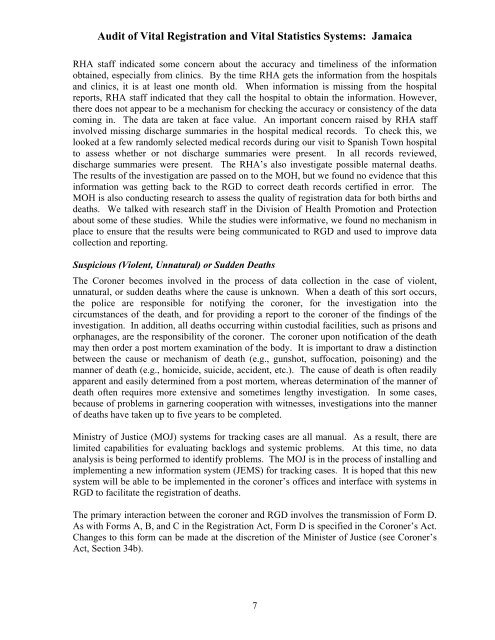Vital Statistics Commission of Jamaica - Planning Institute of Jamaica
Vital Statistics Commission of Jamaica - Planning Institute of Jamaica
Vital Statistics Commission of Jamaica - Planning Institute of Jamaica
You also want an ePaper? Increase the reach of your titles
YUMPU automatically turns print PDFs into web optimized ePapers that Google loves.
Audit <strong>of</strong> <strong>Vital</strong> Registration and <strong>Vital</strong> <strong>Statistics</strong> Systems: <strong>Jamaica</strong><br />
RHA staff indicated some concern about the accuracy and timeliness <strong>of</strong> the information<br />
obtained, especially from clinics. By the time RHA gets the information from the hospitals<br />
and clinics, it is at least one month old. When information is missing from the hospital<br />
reports, RHA staff indicated that they call the hospital to obtain the information. However,<br />
there does not appear to be a mechanism for checking the accuracy or consistency <strong>of</strong> the data<br />
coming in. The data are taken at face value. An important concern raised by RHA staff<br />
involved missing discharge summaries in the hospital medical records. To check this, we<br />
looked at a few randomly selected medical records during our visit to Spanish Town hospital<br />
to assess whether or not discharge summaries were present. In all records reviewed,<br />
discharge summaries were present. The RHA’s also investigate possible maternal deaths.<br />
The results <strong>of</strong> the investigation are passed on to the MOH, but we found no evidence that this<br />
information was getting back to the RGD to correct death records certified in error. The<br />
MOH is also conducting research to assess the quality <strong>of</strong> registration data for both births and<br />
deaths. We talked with research staff in the Division <strong>of</strong> Health Promotion and Protection<br />
about some <strong>of</strong> these studies. While the studies were informative, we found no mechanism in<br />
place to ensure that the results were being communicated to RGD and used to improve data<br />
collection and reporting.<br />
Suspicious (Violent, Unnatural) or Sudden Deaths<br />
The Coroner becomes involved in the process <strong>of</strong> data collection in the case <strong>of</strong> violent,<br />
unnatural, or sudden deaths where the cause is unknown. When a death <strong>of</strong> this sort occurs,<br />
the police are responsible for notifying the coroner, for the investigation into the<br />
circumstances <strong>of</strong> the death, and for providing a report to the coroner <strong>of</strong> the findings <strong>of</strong> the<br />
investigation. In addition, all deaths occurring within custodial facilities, such as prisons and<br />
orphanages, are the responsibility <strong>of</strong> the coroner. The coroner upon notification <strong>of</strong> the death<br />
may then order a post mortem examination <strong>of</strong> the body. It is important to draw a distinction<br />
between the cause or mechanism <strong>of</strong> death (e.g., gunshot, suffocation, poisoning) and the<br />
manner <strong>of</strong> death (e.g., homicide, suicide, accident, etc.). The cause <strong>of</strong> death is <strong>of</strong>ten readily<br />
apparent and easily determined from a post mortem, whereas determination <strong>of</strong> the manner <strong>of</strong><br />
death <strong>of</strong>ten requires more extensive and sometimes lengthy investigation. In some cases,<br />
because <strong>of</strong> problems in garnering cooperation with witnesses, investigations into the manner<br />
<strong>of</strong> deaths have taken up to five years to be completed.<br />
Ministry <strong>of</strong> Justice (MOJ) systems for tracking cases are all manual. As a result, there are<br />
limited capabilities for evaluating backlogs and systemic problems. At this time, no data<br />
analysis is being performed to identify problems. The MOJ is in the process <strong>of</strong> installing and<br />
implementing a new information system (JEMS) for tracking cases. It is hoped that this new<br />
system will be able to be implemented in the coroner’s <strong>of</strong>fices and interface with systems in<br />
RGD to facilitate the registration <strong>of</strong> deaths.<br />
The primary interaction between the coroner and RGD involves the transmission <strong>of</strong> Form D.<br />
As with Forms A, B, and C in the Registration Act, Form D is specified in the Coroner’s Act.<br />
Changes to this form can be made at the discretion <strong>of</strong> the Minister <strong>of</strong> Justice (see Coroner’s<br />
Act, Section 34b).<br />
7

















